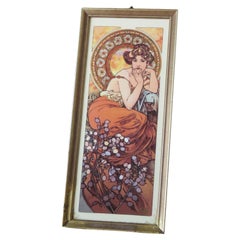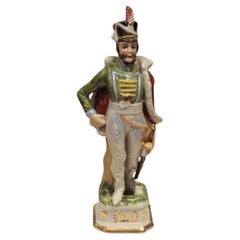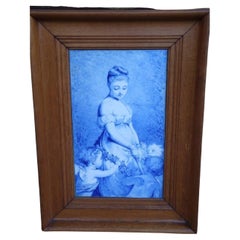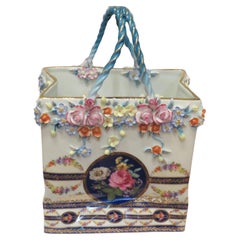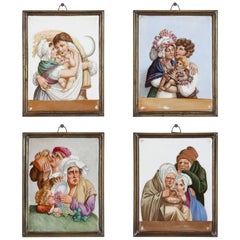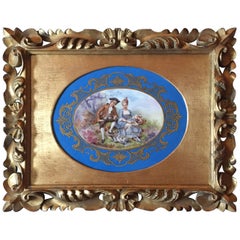R Wholesale Diamond Jewels Porcelain
to
4
4
4
4
4
1
4
3
1
1
4
4
4
1
Important Alphonse Mucha Four Seasons Amber Porcelain Plaque w Swarovski Crystal
By Goebel Company
Located in New York, NY
The Following Item we are offering is a STUNNING AND MAGNIFICENT Large Alphonse Mucha Four Seasons Topaz Amber Painted Porcelain Plaque with Woman w...
Category
20th Century German Porcelain
Materials
Paint, Porcelain
Important Estate Gorgeous Sevres Style Dresden Style Porcelain Napoleon
Located in New York, NY
The Following Item we are offering is this Large Estate Signed Dresden Style RARE LARGE FRENCH NAPOLEON DRESDEN STYLE STANDING PORCELAIN FIGURE. Beautifully Handpainted with Fine Det...
Category
20th Century Unknown Porcelain
Materials
Porcelain
Beautiful Framed 19TH C Painting on Porcelain Woman Children Charles Chaplin
Located in New York, NY
The Following Item we are offering is a Beautiful Museum Quality Painting on Porcelain of a Woman surrounded by Cherubs holding Garland. Magnificently done with Outstanding Detail. Framed in a Beautiful Wooden Frame, inscribed Ch. Chaplin. Taken out of the Penthouse Estate of the President of Prestige Jewelers Upper East Side, New York City.
Framed Measurements: 24" H x 33" W
Charles Joshua Chaplin (8 June 1825 – 30 January 1891) was a French painter and printmaker who painted both landscapes and portraits. He was an accomplished artist mastering different techniques such as pastels, lithography, watercolor, chalk, oil painting and etching. He was best known for his elegant portraits of young women.
Charles Joshua Chaplin was born on 8 June 1825 in Les Andelys, Eure, France. His mother, Olympia Adelle Moisy, was French, whereas his father, John Chaplin, was an art broker from England. Charles Chaplin spent his whole life in France, becoming a naturalized citizen in 1886.[1][2] He studied at the École des Beaux-Arts in Paris from 1840, and he took private lessons in the studio of Michel Martin Drolling, whose apprentices included Paul Baudry, Jules Breton and Jean-Jacques Henner. Later he also taught at the École des Beaux-Arts.[2]
In 1845 he entered the Salon de Paris, the official art exhibition of the Académie des Beaux-Arts, as a portrait and landscape painter with the painting Portrait of the Artist's Mother. Chaplin conducted art classes specifically for women at his studio. The American artist Mary Cassatt, the French artist Louise Abbéma and the English artist Louise Jopling were among Chaplin's students. His son Arthur Chaplin was also a painter. Chaplin died on 30 January 1891 in Paris as a wealthy man and is buried in the Père Lachaise Cemetery.[3][4]
Chaplin made his debut at the Salon with portraits, but he also painted landscapes, particularly the countryside of Auvergne. His early works, from 1848 to 1851, were painted in a more realistic style, and are characterized by an interest in realism, which was a style that had been reestablished in France by the French Second Republic, that had the motto Liberté, égalité, fraternité, and was ruled for three years by the republican government of France from the 1848 Revolution until the 1851 coup by Louis-Napoléon Bonaparte. Realism was an artistic movement that began in France in the 1850s, after the 1848 Revolution.[5] From the late 18th century Romanticism dominated French art and literature but was spurned by Realists, who revolted against the display of the emotions of the Romantic movement, seeking to depict real and characteristic contemporary individuals and situations with truth and accuracy.[6]
Chaplin painted many works in his early days, including floral studies that were displayed at the Salon de las Flores. Later, in the late 1850s, he abandoned naturalism, his earlier style, exchanging it for a more graceful, elegant and supple technique that brought him a certain notoriety in France during his time as a portrait painter; as such he embraced the idyllic and voluptuous and fashionable style of the prominent French painter, François Boucher (1703–1770).[7]
He also embraced the tradition of the great English portraitists. He developed his very own style of painting but was inspired by the British painters Joshua Reynolds and Thomas Gainsborough. He used to engrave the works of the Dutch artist Pieter Paul Rubens and gained further influence from his work.[2]
Later work
Gradually the muddy colours used by Chaplin transformed into white, grey and pink, depicting his models with an opalescent, mother-of-pearl complexion by applying a subtle palette of rosy flesh tones and light greys. After painting portraits and trying his skills on ornamental painting, Chaplin took up genre painting in the 1850s. His favourite subjects are the feminine grace of a young woman’s everyday life. He portrays women in several poses: resting; grooming; singing; and reading. He captures them with lightness and carelessness and accentuates the decorative elements of the composition.[2]
Empress Eugénie, the wife of Napoleon III and an admirer of the "Pompadour style", rapidly fell under the enchantment of the painter's neo-Rococo works. Chaplin was among Napoleon III and Empress Eugénie’s favourite court artists. In 1859, when his portrait of Aurora was banned by the judges of the Salon as "too erotically suggestive", Napoléon III defended Chaplin and overturned the disqualification order.[8] He was similarly valued as an interior decorator and was appointed to remodel the decor of Empress Eugénie's rooms.[8]
His sensual portraits of women and young girls, often with models posed erotically in hazy surroundings and frequently wearing transparent clothing, attracted the interest of the high society and aristocracy of Paris during the French Third Republic (1870–1940) guaranteeing his success and wealth. He was one of the most popular painters of his time, but nowadays his work is almost unknown, in spite of the fact that his works hang in many major museums around the world.[2]
He employed his Rococo style for his mythological scenes and genre scenes paintings. His genre pictures formed a significant part of his work. In 1861, working as a decorative painter. Chaplin painted the doors and several glass panels above them of the Salon des Fleurs in the Tuileries Palace.[3] The Palace was gutted by fire in 1871 and its ruins swiftly demolished.[9] He also undertook decorating work in the Salon de l’Hémicycle of the Palais de l’Elysée.[3]
Honours and awards
A Song Silenced, Private collection.
As a member of the Académie royale de peinture et de sculpture, Chaplin exhibited his paintings at the Salon de Paris, the official exhibition venue of members' work. He began exhibiting his paintings at the French Artists' Salon in 1845 and was represented there habitually each year. These exhibitions made him one of France's most famous portrait artists. Commencing in 1847, his work was exhibited regularly at the Royal Academy in London.[8]
During his lifetime he received acclamation for his artistic talents by the award of several medals: a third class medal in 1851; a second class medal the following year; and an Honour Medal...
Category
20th Century Unknown Porcelain
Materials
Porcelain
Rare Important Gorgeous Sevres Style / Dresden Style Porcelain Shopping Bag
Located in New York, NY
The following Item we are offering is a Spectacular Handpainted Sevres Style / Dresden Style Porcelain Shopping Bag/ Basket with Intricate Colorful Floral Motifs outside and inside o...
Category
20th Century Unknown Porcelain
Materials
Porcelain
Related Items
Four Meissen Porcelain Plaques Depicting the Four Seasons
By Meissen Porcelain
Located in London, GB
This delicately detailed set of four allegorical porcelain plaques portrays family scenes within the theme of the four seasons: Spring, Summer, Autumn and Winter.
Spring can be ide...
Category
Antique Early 19th Century German Folk Art Paintings
Materials
Metal
19th Century Unmarked Sevres Hand-Painted Porcelain Plaque, Hand Carved Frame
By Manufacture Nationale de Sèvres
Located in Vero Beach, FL
A circa 1880 masterpiece of a young couple feeding doves. This is a superb example of a 19th century unmarked Sèvres hand painted porcelain plaque. Signed by the artist R. Deniau. Th...
Category
Antique 1870s French Rococo Decorative Art
Materials
Porcelain, Wood
19th Century Porcelain Dinner Service from the Maison Charles Pillivuyt et Cie
By Charles Pillivuyt & Cie
Located in LA CIOTAT, FR
A gorgeous dinner service from the Maison Charles Pillivuyt et Cie, a manufacturer of high-quality porcelain founded in 1818. Each piece is hand-painted with a delicate rose- pink bo...
Category
Antique Late 19th Century French Napoleon III Dinner Plates
Materials
Porcelain
H 19.69 in Dm 19.69 in
Antique Sevres Style Floral Painted Porcelain Plaque C1880
Located in Big Flats, NY
Antique Sevres Style Floral Painted Porcelain Plaque Signed C1880.
Measures - 10.75"H x 7.5"W.
An antique Sevres style porcelain plaque from circa...
Category
Antique 19th Century Porcelain
Materials
Porcelain
19th Century Porcelain Samovar
By Manufacture Nationale de Sèvres
Located in London, GB
A beautiful and very unusual jewelled porcelain samovar, Sèvres porcelain from the 18 century but decorated in the first quarter of the 19th century, probably in the workshop of Emil...
Category
Antique Mid-19th Century French Napoleon III Porcelain
Materials
Porcelain
6 Antique French Bloch & Bourdois Reticulated Dresden Style Porcelain Plates
By Bloch & Bourdois
Located in Philadelphia, PA
A set of 6 fine French reticulated porcelain plates.
By Bloch & Bourdois.
Decorated throughout with floral sprays, raised gold, gilt highlights, and a reticulated rim.
Simpl...
Category
Antique Late 19th Century French Rococo Porcelain
Materials
Porcelain
19th c. Porcelain Oyster Plate
Located in Winter Park, FL
A late 19th century porcelain oyster plate made by the Union Porcelain Works of Greenpoint, New York. Hand-painted with gilt accents. Nicely shaped and molded with five shallow well...
Category
Antique Late 19th Century Porcelain
Materials
Ceramic
19th Century Italian Porcelain Centerpiece
Located in Dallas, TX
Late 19th century Italian porcelain centerpiece. Classical design depicting the four seasons.
Category
Antique 19th Century Italian Centerpieces
Materials
Porcelain
Royal Copenhagen Bisque Porcelain Plaque
By Bertel Thorvaldsen
Located in Firenze, IT
SHIPPING POLICY:
No additional costs will be added to this order.
Shipping costs will be totally covered by the seller (customs duties included).
Copenhagen bisque porcelain plaques...
Category
Early 20th Century Danish Neoclassical Revival Porcelain
Materials
Porcelain
Massive Sevres Style Porcelain and Gilt Bronze Centrepiece
Located in London, GB
19th century sevres style centrepiece with impressive gilding all around it.
Category
Antique Late 19th Century French Planters, Cachepots and Jardinières
Materials
Porcelain
Antique Meissen Porcelain Figurine, Woman Playing the Flute, Late 19th Century
Located in Copenhagen, DK
Antique Meissen porcelain figurine. Woman playing the flute. Late 19th century.
Measures: 24.5 x 12 cm.
In very good condition. A...
Category
Antique Late 19th Century German Rococo Revival Porcelain
Materials
Porcelain
Royal Copenhagen Bisque Porcelain Plaque
By Bertel Thorvaldsen
Located in Firenze, IT
SHIPPING POLICY:
No additional costs will be added to this order.
Shipping costs will be totally covered by the seller (customs duties included).
Copenhagen bisque porcelain plaques...
Category
Early 20th Century Danish Neoclassical Revival Porcelain
Materials
Porcelain
